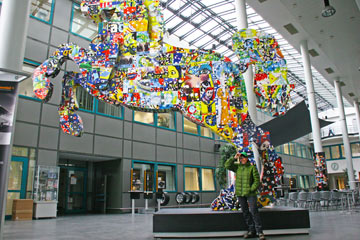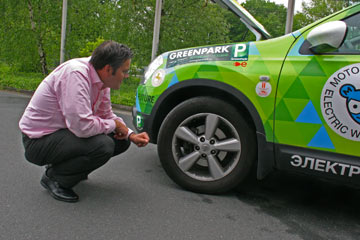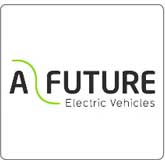4-5. CONTINENTAL


Goslar Times got a short interview with us in the morning, before we rolled silently north to Hannover. Continental has been a solid sponsor of our expedition. Klaus Engelhart and Markus Fischer received us in the giant company's research department in Hannover. Several thousand people work here to develop new tires. Markus told us how they seek a better compromise between rolling resistance and braking power with experiments on new and larger tire-dimensions, fx. 20 inches. We also got time to tell the press from Hannover about our experiences. At the Silver Lake near Celle we found a small camp site. We sat for a long time on a bench and enjoyed the sun. In the morning there was ice on the tent and Green Car, but we had slept soundly.
Hjalte
Electric car visits Continental on its round-the-world trip
06.05.2011

Hanover, May 04, 2011. The first round-the-world trip with an electric car is coming to a successful end: After 30,000 km, Nina and Hjalte Tin from Denmark are soon to reach their destination – the Danish capital of Copenhagen. Their car, an electrically powered Nissan Quasquai, was fitted with Continental tires for the round-the-world trip. As a lower rolling resistance is particularly important for cars with an electric drive – due to the lower rolling resistance increasing the range – the car was fitted with the ContiPremiumContact 2 tires.
From the Continental research and development center in Hanover-Stöcken, these tires offer not only a low rolling resistance but also a high level of resilience so as to reliably last for the entire round-the-world trip.
The globetrotters covered the journey distance in ten months, setting off from Denmark and travelling through Norway, Sweden, Estonia, Russia, Mongolia, China, the U.S.A., Spain, France, Switzerland, Germany and the Netherlands before finally returning to Copenhagen. On the last section of their journey, Nina and Hjalte Tin want to find out a little more about their tires and are therefore making a brief stop at Continental in Hanover.
As the electric car has a relatively restricted range of 200 km, the main challenge when planning the stages was to ensure the car was appropriately ‘fueled’. During the round‑the‑world trip, they sourced their electricity from garages, camp sites, hotels and even private homes. “We want to use our trip to show that ‘green mobility’ is a perfectly feasible alternative”, commented the pair. “Electric cars can help stop climate change all over the world.”











Post new comment